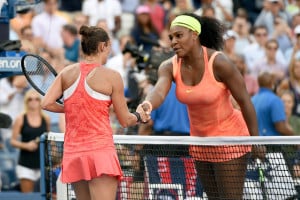15. Serena Williams: And Still She Rises
Serena Williams has redefined the phrase “play like a girl” perhaps more than any other woman. She and her sister, Venus, have played on their own terms, tuning out naysayers while letting their rackets speak for them — loudly and victoriously over and over again.
She’s the first woman to make our “15 Fiercest Sisters” list more than once. And she’s the first woman in three decades to grace Sports Illustrated’s cover as Sportsperson of the Year — the best athlete of 2015, period.
She makes this point crystal clear for younger athletes attempting to follow in her fashionably fierce sneakers, highlighting the 21 grand slams that she’s won against the odds, the death of a sister, the haters and racists, the injuries and even blood clots in both lungs. It took lots of love and support, discipline, hard work, determination and most of all, self-belief, she says.
 So, Serena missed out on a calendar Grand Slam — winning four consecutive major tournaments in a single year to break Steffi Graf’s 1988 record. But Serena has broken all sorts of other records and made all sorts of history.
So, Serena missed out on a calendar Grand Slam — winning four consecutive major tournaments in a single year to break Steffi Graf’s 1988 record. But Serena has broken all sorts of other records and made all sorts of history.
At age 21, Serena won a career slam in singles, winning the four major Grand Slam tournaments between 1999 and 2003 (Wimbledon as well as the Australian, French and U.S. Opens). She and Venus also won a career slam in doubles between 1999 and 2001. Together and separately, the Williams sisters have inspired all sorts of girls by remaining unapologetically and uniquely Serena and Venus — in other words Fierce!
William C. Rhoden puts Serena’s career (and loss to Roberta Vinci of Italy) in historical context in a New York Times article, “Serena Williams Legacy Extends Beyond Grand Slam Bid.”
“Great athletes generally do not live for history,” Rhoden writes. “They simply make history.”
“Vinci had the luxury against Serena of simply playing. Serena, however, like every great player in every generation, was playing against yet another supercharged opponent with nothing to lose. She was also playing as much against historic figures like Althea Gibson and Arthur Ashe Jr. looking over her shoulder, and against Margaret Court and Steffi Graf, who represent mountains still to climb.”
Rhoden also points out how Serena has rewritten the gender script in sports and how her athleticism is on par with Michael Jordan, Kobe Bryant and LeBron James. “Despite the loss,” Rhoden says, “she has played a pivotal role in breaking open the gender box in which women athletes are often put: the best female player, the best female athlete.”
He quotes other athletes on Serena’s greatness, including Bethanie Mattek-Sands, whom Serena defeated 3-6, 7-5, 6-0 at the U.S. Open.“Does she deserve to be called just the best athlete, period?” Mattek-Sands asked. “I think so. I don’t know if she would say it, but I think a lot of fellow athletes would agree with that statement.”
Maybe Serena wouldn’t have agreed then, but in her SI acceptance speech she conveyed her pride with being named Sportsperson of the Year and not Sportswoman of the Year.
She also made it clear that she isn’t done yet and that she has more growing to do. She closed by reading part of a Maya Angelou poem, stating “And still like dust, I rise!”
DOCUMENTING HISTORY: Sports Illustrated Films chronicles the ups and downs of Serena Williams’ life and career.
POETIC JUSTICE: Serena Williams quotes Maya Angelou’s poem “And Still I Rise” in accepting Sports Illustrated’s award as Sportsperson of the Year.









